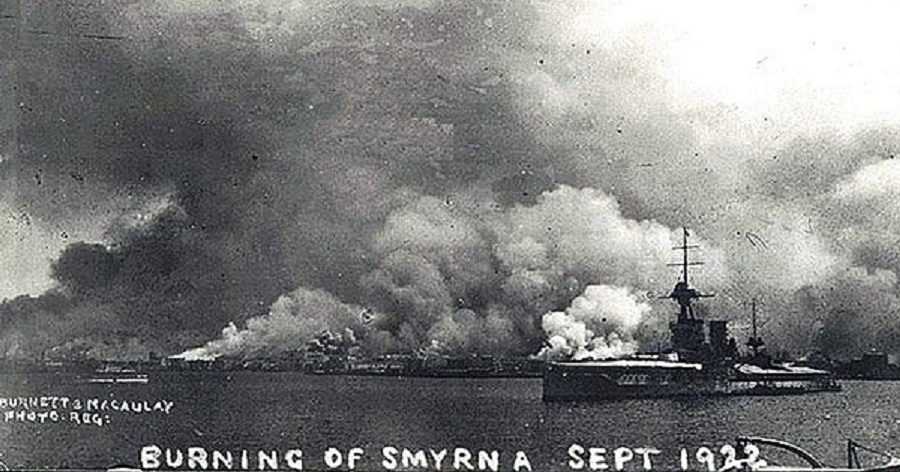
Smyrna ablaze as the HMS Iron Duke is in the harbor. 14 September 1922. Photo: Burnett & Macaulay.
The final phase of the Greek Genocide took place at Smyrna (Tr: İzmir) in September 1922 when Kemalist forces entered the city and took part in an orgy of looting, rape and massacre that targeted the city's Christian population, primarily Greeks and Armenians. They then burnt the city to the ground. The term Smyrna Holocaust refers to the wholesale slaughter of the Smyrna populace, which at the time was majority Christian, and also to the fire that completely destroyed the city.
The Lead Up
During the Ottoman period, the Turks referred to Smyrna as Gâvur İzmir (Infidel Smyrna) due to its large Christian population. According to the Consul at Smyrna George Horton, at the time of its destruction, Smyrna had a population of at least 400,000 comprising 165,000 Turks, 150,000 Greeks and 25,000 Armenians. The remainder were made up Jews, Italians, French, British and other nationalities.1
Amid a climate of physical destruction of Greek communities in the Ottoman Empire, Greece entered WW1 in 1917 on the side of the Allies and on May 15, 1919 after an arrangement with the Allies, arrived at Smyrna.
In a telegram dated May 11, 1919, Arthur James Balfour, British Secretary of State for Foreign Affairs stated:
With a view to avoiding disorders and massacres of Christians in Smyrna and its environs, the occupation of the town and forts by Allied Forces has been decided upon by president [Wilson], Prime Minister [Lloyd George] and M. Clemenceau. Greek troops are on their way to Smyrna and Turks will be summoned to hand over forts to a landing party.2
While the Hellenic military was considered a liberator to the many Christian populations of Smyrna, nationalist Turks considered it an invasion and a war eventually resulted between the Hellenic military and nationalist forces under the command of Mustafa Kemal.
Although originally supported by the Allies, Greece was later abandoned and its military found itself isolated and under attack. Kemalist forces eventually defeated the Hellenic military causing them to retreat towards western Anatolia. Without protection and fearing reprisals, thousands of Ottoman Christians followed the military.
Death Toll
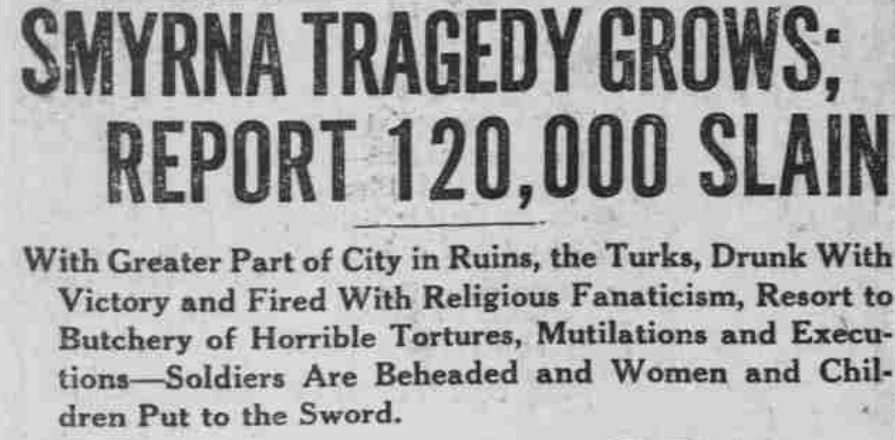
The Topeka State Journal, 16 Sep 1922, p.1.
A despatch from Smyrna dated September 14 recorded a death toll of approximately 1,000 with an unknown number killed and still trapped in the burning area.3 A news piece from London dated September 15 quoted an American Relief official who said the death toll was at least 120,000.4 The US Consul at Smyrna, George Horton estimated that at least 100,000 perished during the fire.5 However, the death toll was likely significantly higher since the Smyrna population before and after the fire show 190,000 unaccounted for.6
Evacuation
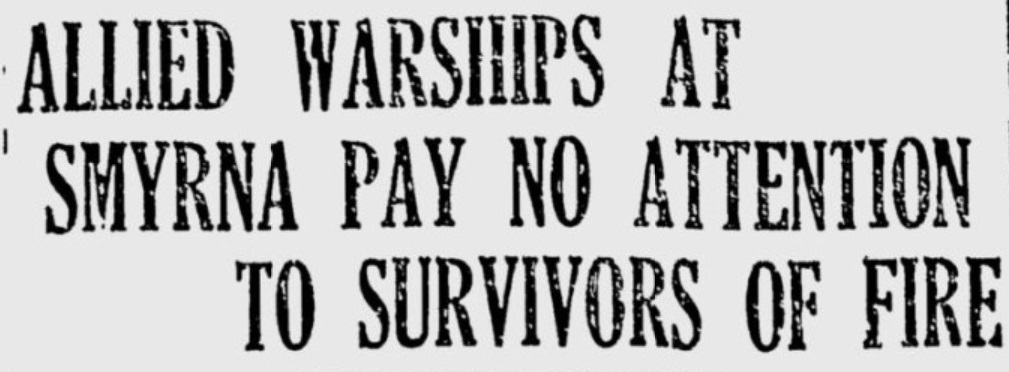
Nashua Telegraph, 21 Sep 1922, p.4.
Although originally refusing to evacuate terror-stricken refugees in order to maintain their neutrality, allied warships eventually rescued the surviving refugees who were transporterd to Greece. According to an American source, 213,480 refugees of various nationalities were evacuated.7
Responsibility
Based on numerous eye-witness accounts, it is undeniable that the Turks were responsible for the vast atrocities committed at Smyrna in September 1922. However, doubt still remains in some circles as to who was responsible for issuing the orders to burn the city and the role that Mustafa Kemal played in its destruction.
Nurettin Paşa (1873-1932), who was the military commander of Smyrna when the city was destroyed, was renowned for his fanaticism and cruelty towards Greeks and Armenians. Mustafa Kemal's biographer Andrew Mango states that after entering Smyrna, Nurettin "was determined only on revenge."8 According to Turkish historian Süleyman Külçe, Nurettin was responsible for the fire.9 Turkish journalist and author Falih Rifki Atay states that if it had not been for Nurettin, the events at Smyrna would have turned out very differently.10
As the city of Smyrna was burning, Mustafa Kemal witnessed the scene and while pointing at the fire, declared that it was "..a sign that Turkey is purged of the traitors, the Christians, and of the foreigners, and that Turkey is for the Turks."11
He also stated: "Let it burn, let it crash down."12
Timeline of Events
1914-1918
Beginning in May 1914, the Greeks of Smyrna experienced boycotts, arson, pillage, massacre and deportations.13 14 15 16 17
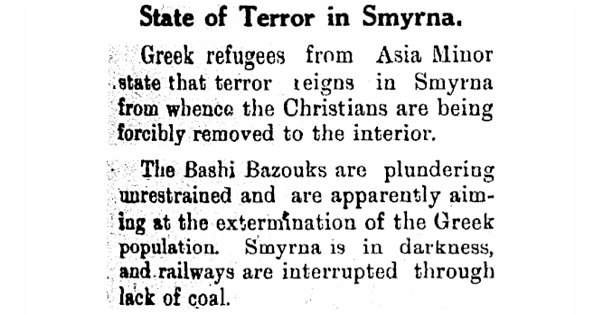
State of Terror in Smyrna. Bay of Plenty Times, 8 Sep, 1915, p.3.
1922
26 August
On the 26th of August 1922, the Greek front in Asia Minor, 200 miles east of Smyrna collapsed. News of the collapse didn't reach Smyrna for days. Three days after the collapse, an English traveler described the mood in the city as mostly relaxed. But on the 1st of September, wounded and fleeing soldiers began arriving on trains, carriages and freight cars.
2 September
By September 2, panic began to spread among the Christians in Smyrna and many residents tried to leave.
4 September
On September 4, the Greek government made a request to the British government to arrange an armistice with the Kemalists for an immediate and orderly evacuation of Hellenic forces from Asia Minor. The armistice did not eventuate.18
5 September
On the 5th of September, civilians from the interior began to flood in. The Smyrna Relief Committee which monitored the arrival of refugees by train and by foot estimated they were arriving at a rate of 30,000 a day.19
The Kemalists sent a note to the League of Nations on the 5th of September alluding to alleged atrocities by the retreating Hellenic forces. It read: "Turkey declines all responsibility for any consequences that may arise from these terrible consequences." The League considered, that by intimating an inability to control his troops, Mustafa Kemal was trying to escape liability for atrocities that were almost certainly going to happen.20
8 September
On the morning of the 8th of September 1922, the Greek High Commissioner at Smyrna announced that the Greek administration of the city would end that night. The last of the Greek officials to leave Smyrna was Aristidis Sterghiades who handed over the keys of the Konak (administration headquarters) to the French Consul, then boarded a ship to be taken away. Even until the next morning, Smyrna remained silent.21
9 September
The next morning, Turkish Kemalist forces rode into Smyrna with sabres drawn and revolvers ready. They were met by a British official who told them that Hellenic forces and civil servants had left the city and advised them to restore confidence.22 Nurettin Paşa issued an order to his troops to harm nobody on entry to the city, but it wasn't long before the looting and massacres began.23 Armenian and Greek shops were the first to be looted by Turkish civilians and soldiers who simply helped themselves. Italian and Turkish patrols stood by and offered no interference.
Lieutenant Commander Harrison Knauss of USS Simpson witnessed the violence first-hand late in the afternoon. As he passed the Greek and Armenian neighbourhoods, there were bodies lying about, shot in the face or back, at close range. The victims were young and old, mostly men but there were also bodies of old women on the street.24
10 September
Turkish forces moved from house to house in the Armenian quarter systematically murdering civilians not before taking all their cash and jewelry and raping women and girls.25 US officials witnessed countless murdered bodies littered throughout the streets of Smyrna as Turks terrorized helpless refugees on the harbor. It was abundantly clear - even before Smyrna was torched - that the Kemalists had no intention of taking the city peacefully, and that the Greek and Armenian residents of the city who had been sympathetic to the Allied occupation, would be severely dealt with.
Kemalist military commander Nurettin Paşa summoned the Metropolitan of Smyrna Chrysostomos to the Konak and cried out to a waiting mob to "treat him as he deserves." The mob tore out the Metropolitan's beard, gouged out his eyes with knives and cut off his ears, nose and hands.26
11 September
The head of the American humanitarian organization Near East Relief, Mr Harold Jaquith and other American officials met with Kemalist military commander Nurettin Paşa and suggested to him that the only solution to the humanitarian problem facing the city was to get the refugees back to their homes. Nurettin thought that was entirely out of the question. He replied: "Take them away. Bring ships and take them out of this country. That is the only solution."27
Nurettin had a reputation for fanaticism and cruelty.28 He had been implicated in massacres of Greeks and had once suggested not only deporting the Greek and Armenian populations in Anatolia but also killing them.29
12 September
Violence against refugees was worsening. US Consul George Horton reported that nine cartloads of bodies were removed from the Konak and three cartloads near the Point Station.30 A British officer commented that on Tuesday [Sep 12], a visit to the Armenian quarter was, literally like entering a "city of the dead."31
Near East Relief's Harold Jaquith reported from Smyrna that 700,000 [mainly Greeks & Armenians] in the city faced famine due to the Turkish occupation and cutting of relief supplies.32
13 September
Early in the morning of Wednesday 13 September, American naval officers received reports of houses burning in the Armenian quarter of Smyrna. Due to the force of a south wind, the fire soon engulfed the Greek quarter of the city, as well as the European neighborhood as it swept towards the Quay.
Kemalist soldiers were seen entering buildings and upon their departure, explosions and fire would break out. Miss Minnie Mills, dean of the American Collegiate Institute for girls which was located in the Basmahane district of Smyrna close to where the fire first broke out, saw Turkish soldiers breaking into nearby homes, lighting fires, and spreading them with petroleum they poured from tins.33
As the fire spread, and with exits to the city blocked by Turkish troops, terror-stricken Christians fled their homes and moved towards the Smyrna shoreline. Approximately 500,000 - 700,000 people were packed in an area one and a half miles long and no more than 100 feet wide.
Major Arthur Davis on the Iron Duke of His Majesty's Marines watched through his binoculars and witnessed figures pouring buckets of liquid among the refugees. At first he thought they were firemen attempting to extinguish the flames, then realised to his horror that every time they appeared, there was a sudden burst of flames. "My God! They're trying to burn the refugees! he exclaimed. The British consuls who were also present concurred.34
By Wednesday evening, evacuation effort began. And by 10 o'clock Thursday morning (Sep 14), about 20,000 refugees had been rescued by US sailors aboard the USS Litchfield.
16 September
With the odor of burned flesh still hovering over the remains of a smouldering Smyrna, a circular signed by Nureddine Paşa issued an ultimatum to the remaining Greeks and Armenians still remaining in the city. All Greek and Armenian males between 18 and 45 years of age were declared prisoners of war and were denied passage out of Turkey (most were later massacred). All other Greeks and Armenians were permitted to leave Turkey by October 1. Those remaining after the deadline, mostly women and children, were faced with the prospect of being driven into the Turkish interior, which was in effect a death sentence.35
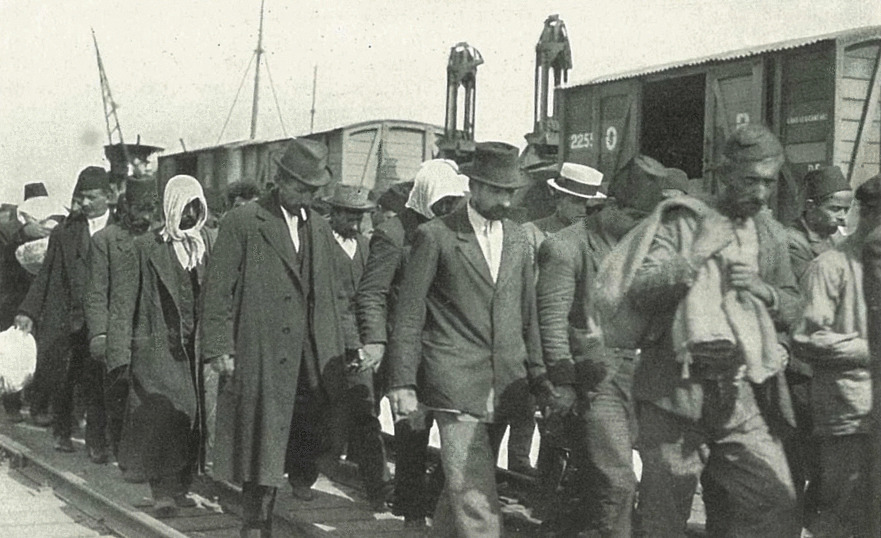
Men of military age torn away from their wives and children and led away in groups for deportation to the interior. The National Geographic Magazine, Nov 1925, p. 562. Photo: C. D. Morris.
17 September
By September 17, forced deportations had begun. American patrols and officials witnessed refugees being herded into large groups and escorted eastward out of the town towards the Anatolian interior.36
19 September
A Near East Relief cablegram reported a death toll of around 10,000 at Smyrna with an unknown number of deceased still in their homes. Thousands were prevented from escaping. The NER also witnessed large groups of people being marched to the interior following the fire.37
In November 1922, Susan Wealthy Orvis, a US missionary who was working in a Near East Relief school in the interior of Turkey, witnessed a line of a thousand refugees, mainly women and children, being marched from Smyrna to their death in the Taurus mountains.38
21 September
A cable sent by the Near East Relief at Constantinople reported that a delay by the Allied governments to take vigorous measures to evacuate the refugees from Smyrna was furnishing an opportunity for the Turks to despatch hundreds to death by deportation. Groups were driven by soldiers from the quay through the city to unknown destinations in the interior. Young Greek and Armenian girls were torn from their families and disappeared.39
22 September
A Near East Relief cablegram reported that deportations at Smyrna were continuing. American humanitarians were reporting that many refugees were dying of exhaustion and many people had gone insane. Others who were fearing removal to the interior where certain death awaited them had committed suicide in the sea.40
Eye-witness accounts
Rev. Charles Dobson
Reverend Charles James Hamilton Dobson (1886-1930) was an Anglican chaplain who was an eye-witness to the Smyrna Holocaust in September 1922. His account was published in 1923 in a piece titled The Smyrna Holocaust and describes his experience at Smyrna just prior to his escape.
I was in Smyrna when the Kemalist troops entered the city. For some days previous to this entry, there was increasing apprehension among the residents... With regard to burials, people kept coming to me and showing me bodies thrust behind hedges and in some cases lying in carts. I was particularly struck with one group consisting of women and babies, and a young girl, almost nude, shot through the breast, and with clotted blood on her thighs and genital organs, that spoke only too clearly of her fate before death. These bodies were buried by Orthodox priests...We heard at the back of our house, one day, a lot of cheering in which I recognised the Turkish word 'padishah' (Sultan, I think). On looking out, I saw about two hundred Greeks or Armenians kneeling and sitting on the road, guarded by Turkish soldiers. I afterwards learned from an absolutely unimpeachable source that these men were subsequently butchered... In the back streets there was, in some parts, a great running of terror-stricken people, carrying children and bedding; some of them had been injured; one man had his face smashed and his mouth bleeding. There was constantly shooting in the back streets, followed by screams and panic-stricken running. The Turks were openly looting everywhere. One man was shot through both thighs, one of which was fractured, his screams were unheeded by the terror-stricken people... I was astonished when in Italy, and again here in France, to find how unwilling some circles were to believe the culpability of the Turkish troops in the burning of Smyrna. It seems to me the firing of the city by the fanatic element of the Turkish Army was the natural culmination of the breakdown of restraints imposed by military necessities, and of the unbridled indulgence of xenophobia.41
Minnie B. Mills
Minnie Belle Mills (1872-1965) was an American missionary who was present at Smyrna in September 1922 when the cosmopolitan city was torched and ultimately destroyed by Kemalist forces. Mills was dean of the American Collegiate Institute for girls (otherwise known as the American Girls' School) which was located in the Basmahane district of Smyrna close to where the fire first broke out. On the day the fire started, Mills witnessed Turkish soldiers pouring petroleum into houses near the college. She described the events as follows:
Soon after lunch fire broke out very near the school, and spread rapidly. I saw with my own eyes a Turkish officer enter a house with small tins of petroleum or benzine, and in a few minutes the house was in flames. Our teachers and girls saw Turks in regular soldiers' uniforms, and in several cases in officers' uniforms, using long sticks with rags at the end which were dipped in a can of liquid, and carried into houses which were soon burning. There was no one in the streets at that time, but bands of Turkish soldiers.42
Falih Rifki Atay
Falih Rifki Atay (1894-1971) was a Turkish author and journalist who witnessed the burning of Smyrna. In his book titled Çankaya, he wrote:
As I have decided to write the truth about what I know I would like to extract a page from my notes that I took at the time here. Pillagers helped the fire to grow [...] Why were we burning Izmir? If the mansions along the waterfront, the hotels and casinos were to stay, were we scared we would never be able to free ourselves of the minorities? During the First World War when the Armenians were being deported, again we had burnt every district and neighbourhood in the Anatolian cities and towns because of this very same fear. This wasn't something that solely derived from the urge for destruction. The feeling of inferiority played a part. A corner that looked like a piece of Europe, that looked Christian or foreign, was destined not to be ours. If there was another war and we were defeated, was leaving Izmir as barren land sufficient enough to protect its Turkishness? If it wasn't for Nurreddin Paşa, who I had known to be a strong fanatic and an enraged demagogue, I believe this tragedy would not have reached such proportions.43
1. Horton, G. The Blight of Asia. Bobbs-Merrill, 1926, pp.101-102.
2. Secret telegram sent by A.J. Balfour from Paris dated 11 May 1919, Foreign Office, British National Archives, FO 141/580/1 quoted in Hofmann et. al, The Genocide of the Ottoman Greeks, Caratzas 2011, p.198.
3. Smyrna Burning. The New York Times. 15 Sep 1922, p.1.
4. Smyrna Given to Torch; Many Thousands Die. Bisbee Daily review, Sep 16, 1922, p.1.
5. Horton, Blight of Asia. pp. 173-175.
6. Dobkin, Marjorie H. Smyrna 1922: The Destruction of a City. New York, NY: Newmark Press, 1998, p. 201.
7. Hatzidimitriou, C. American Accounts Documenting the Destruction of Smyrna by the Kemalist Turkish Forces, Sep 1922. Caratzas, 2005, p.118.
8. Mango, A. Atatürk. John Murray 1999, p.345.
9. Hlamides, N. The Smyrna Holocaust: The Final Phase of the Greek Genocide in Hofmann, T. et. al, The Genocide of the Ottoman Greeks. Caratzas 2011, p. 222.
10. ibid, p. 222.
11. Armstrong, H.C. Grey Wolf. Mustafa Kemal: An Intimate Study of a Dictator. Penguin books, 1940, pp.158-159.
12. Mango, A. Atatürk, 346.
13. Turkish Persecution of Greeks. The Times, Apr 18, 1914, p.7.
14. Massacre of Greeks. Daily Telegraph, Apr 22, 1916, p.7.
15. State of Terror in Smyrna. Bay of Plenty Times, 8 Sep, 1915, p.3.
16. Persecution of the Greeks in Turkey since the Beginning of the European War, New York 1918, p.66.
17. Greeks' Plight Desperate. The Herald, Victoria (Aus), Jan 13, 1915, p.5.
18. Armistice Appeal Issued by Greece. Auckland Star, Volume LIII, Issue 210, 5 September 1922, p.5. accessed on Aug 27, 2022. https://paperspast.natlib.govt.nz/newspapers/AS19220905.2.43
19. Ureneck, L. The Great Fire, Harper Collins, p. 110.
20. Kemalists' Threat. Daily Telegraph (UK), 12 Sep 1922 quoted in Oeconomos, L, The Martyrdom of Smyrna and Eastern Christendom, George Allen and Unwin, 1922, p.91.
21. Dobkin, Smyrna, 114-115.
22. Hlamides, Smyrna Holocaust. 202.
23. Horton, Blight of Asia. 128.
24. Ureneck, Great Fire, 150.
25. Dobkin, Smyrna, 135.
26. Dobkin, Smyrna, 133-134.
27. Shenk, R. America's Black Sea Fleet, Naval Institute Press, 2012, pp. 215-216.
28. Kinross. Ataturk: A Biography of Mustafa Kemal, Father of Modern Turkey, New York 1965, p. 370.
29. Akçam, T. A Shameful Act, Metropolitan Books, 2006, p, 323.
30. Horton, Blight of Asia, 133.
31. Ureneck, Smyrna, 187.
32. Supplement to the New Near East, Vol. III, No. 11, Oct. 1922.
33. Bierstadt E, The Great Betrayal: A Survey of the Near East Problem, Robert M. McBride and Co, New York 1924, p. 34.
34. Dobkin, Smyrna, 170.
35. Solomonidis, V. Greece in Asia Minor. The Greek Administrationof the Vilayet of Aidin, 1919-1922, thesis submitted, King's College, pp. 259-260.
36. Ureneck, Smyrna, 294-297.
37. Supplement to the New Near East, Vol. III, No. 11, Oct. 1922.
38. They Are Being Punished, The New Near East, Feb 1923, p 12.
39. Supplement to the New Near East, Vol. III, No. 11, Oct. 1922.
40. ibid.
41. Rev. Charles Dobson, The Smyrna Holocaust appendix in Lysimachos Oeconomos, The Tragedy of the Christian Near East, London 1923, pp. 21-29.
42. Bierstadt E, The Great Betrayal: A Survey of the Near East Problem, Robert M. McBride and Co, New York 1924, p. 34.
43. Falih Rifki Atay. Çankaya: Atatürk'ün Doğumundan Ölümüne Kadar, Istanbul 1969, 322-325 quoted in Hlamides, The Smyrna Holocaust, 206-207.



